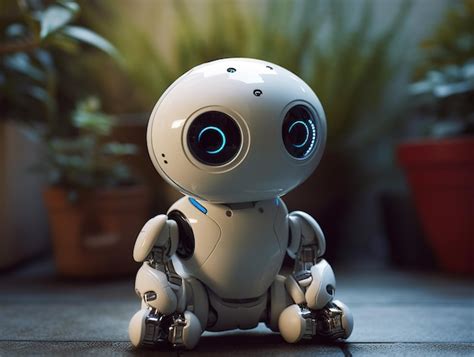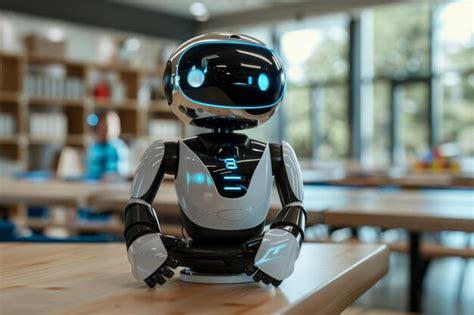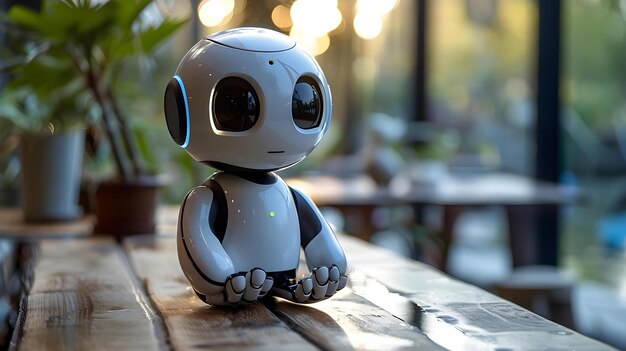Vector robots are revolutionizing the landscape of personal assistance and automation with their advanced AI capabilities and intuitive design. As a cutting-edge example of robotics and machine learning integration, Vector robots offer a glimpse into the future of intelligent personal assistants. Their ability to interact seamlessly with users and adapt to various applications across industries showcases the potential of robotics in enhancing efficiency and productivity. In this article, we’ll explore the diverse capabilities of Vector robots, their role in automation, and the latest advancements driving their development. We’ll also compare them with other personal assistants and discuss future trends shaping the field of robotics.
Join hotelfiler.com as we delve deeper into this topic.
1. Overview of Vector Robots and Their Capabilities
Vector robots represent a significant leap in personal assistant technology, blending advanced robotics with artificial intelligence. Designed by Anki, these compact, autonomous robots are equipped with a range of sensors, including a high-definition camera, an array of microphones, and infrared sensors, enabling them to navigate environments, recognize faces, and respond to voice commands. Vector’s capabilities extend beyond simple tasks; it can interact with users through natural language, perform actions such as taking photos or setting reminders, and provide real-time information like weather updates. Its ability to learn and adapt to user preferences through machine learning algorithms ensures that it becomes more efficient over time. With its engaging personality and versatile functionality, Vector serves as a model for the next generation of personal assistants, illustrating how robotics can enhance daily life and drive automation across various sectors.

2. AI Integration and Machine Learning in Vector Robots
Vector robots are powered by sophisticated AI and machine learning technologies that enable them to perform a range of tasks with remarkable efficiency. At the core of Vector’s functionality is its ability to process and analyze data in real-time, allowing it to interact intelligently with users and adapt to their needs. AI integration allows Vector to understand and respond to natural language commands, recognize faces, and perform complex actions such as taking photos or setting reminders.
Machine learning algorithms enhance Vector’s capabilities by enabling it to learn from interactions and experiences. As it gathers data from its environment and user interactions, Vector refines its responses and behaviors, becoming more attuned to individual preferences and routines. This continuous learning process ensures that Vector improves its performance and accuracy over time, providing a more personalized and efficient user experience.
Additionally, Vector’s AI and machine learning systems contribute to its autonomous navigation and obstacle avoidance, allowing it to move seamlessly around its environment. By leveraging these advanced technologies, Vector robots exemplify the potential of AI and machine learning in creating dynamic, responsive personal assistants that can enhance automation and productivity across various applications.

3. Applications of Vector Robots in Various Industries
Vector robots are finding diverse applications across multiple industries due to their versatile capabilities and advanced technology. In the consumer sector, they serve as interactive personal assistants, providing users with real-time information, reminders, and entertainment. Their ability to recognize faces and understand natural language makes them valuable tools for enhancing user engagement and personalization.
In retail, Vector robots are used to assist with customer service, offering product information and navigating store environments. Their interactive features can enhance the shopping experience and streamline operations.
Healthcare facilities benefit from Vector robots by utilizing them for patient engagement and monitoring. They can help with reminders for medication, provide companionship, and assist in managing daily tasks.
In the education sector, Vector robots are employed as educational tools, aiding in interactive learning and providing students with a unique, tech-driven approach to education. Their adaptability and learning capabilities make them effective in supporting various educational applications and fostering a more engaging learning environment.

4. User Experience and Interaction with Vector Robots
User experience with Vector robots is designed to be intuitive and engaging, reflecting the advanced AI and machine learning technologies that power them. Users interact with Vector through natural language, and the robot responds with clear, contextually relevant answers. The high-definition camera and array of sensors enable Vector to recognize faces and detect voices, allowing for personalized interactions and a responsive experience.
Vector’s small, interactive screen displays expressive animations and information, making communication with the robot both informative and entertaining. The robot’s ability to perform tasks such as setting reminders or taking photos adds practical value to its interactions.
Overall, the user experience with Vector is characterized by its ease of use, adaptability to individual preferences, and the seamless integration of its advanced features into everyday activities. This combination of functionality and personalization ensures a satisfying and efficient interaction for users.
5. Role of Vector Robots in Automation and Efficiency
Vector robots play a significant role in enhancing automation and efficiency across various applications. Their advanced AI and machine learning capabilities enable them to handle a range of tasks autonomously, reducing the need for manual intervention. In consumer settings, Vector assists with scheduling, reminders, and real-time information retrieval, streamlining daily routines and increasing productivity.
In business environments, Vector robots contribute to operational efficiency by automating customer service interactions, providing instant responses to inquiries, and navigating through complex store layouts. This not only improves customer experience but also frees up human resources for more complex tasks.
In healthcare, Vector aids in patient management by automating reminders for medications and monitoring patient interactions, enhancing the efficiency of healthcare delivery. Its adaptability allows it to integrate smoothly into various workflows, optimizing processes and reducing operational overhead. Overall, Vector robots exemplify how automation can be leveraged to enhance productivity and efficiency in diverse sectors.
6. Innovations and Advancements in Vector Robot Technology
Innovations in Vector robot technology highlight significant advancements in robotics and AI. Recent developments focus on enhancing the robot’s interaction capabilities and autonomy. For instance, improved sensors and cameras have bolstered Vector’s ability to navigate environments and recognize faces with greater accuracy. These enhancements enable more precise and personalized interactions.
Advancements in machine learning algorithms have also played a crucial role, allowing Vector to learn from user interactions and adapt its responses over time. This continuous learning process enhances the robot’s efficiency and effectiveness in performing tasks and understanding user preferences.
Additionally, updates to Vector’s software have introduced more sophisticated voice recognition and natural language processing features, making communication more seamless and intuitive. Innovations in hardware design have contributed to a more compact and aesthetically pleasing form factor, integrating advanced technology into a user-friendly device. These ongoing advancements ensure that Vector remains at the forefront of personal assistant robotics, driving the future of automation and user interaction.
7. Comparison of Vector Robots with Other Personal Assistants
When comparing Vector robots to other personal assistants, several distinctive features and advantages emerge. Unlike traditional voice assistants like Amazon’s Alexa or Google Assistant, Vector robots combine physical presence with advanced AI capabilities. While voice assistants rely primarily on audio commands and lack physical interaction, Vector offers a tangible, interactive experience through its expressive screen and autonomous movement.
Vector’s integration of sensors and cameras allows it to recognize faces, navigate environments, and perform physical tasks, which sets it apart from purely digital assistants. This physicality enables Vector to engage users in a more interactive and personalized manner. Additionally, Vector’s machine learning algorithms continually improve its performance and adaptability, offering a dynamic and evolving user experience.
In contrast, other personal assistants often lack the same level of autonomy and physical interaction, focusing instead on providing information and controlling smart home devices. Vector’s ability to perform a variety of tasks, coupled with its engaging personality, provides a more immersive and versatile experience. This makes Vector a unique contender in the realm of personal assistants, combining the best aspects of robotics and AI to enhance daily life and automation.
8. Challenges and Limitations of Current Vector Robots
Despite their advanced capabilities, current Vector robots face several challenges and limitations. One primary concern is their dependency on a stable internet connection for full functionality. Without consistent connectivity, the robot’s ability to perform tasks and update its software can be significantly hindered.
Additionally, while Vector excels in personal interaction and task automation, its physical size and battery life can be limiting factors. The compact design, while advantageous for home use, may restrict its effectiveness in larger or more complex environments. Battery life constraints also necessitate regular recharging, which can disrupt continuous usage.
Another challenge is the integration with other smart devices and systems. While Vector performs well within its designed ecosystem, compatibility with a wide range of third-party applications and devices may be limited, potentially reducing its versatility.
Finally, the cost of advanced robotics technology can be a barrier for broader adoption. Despite its innovative features, the price point of Vector robots may limit their accessibility to a wider audience.
9. Future Trends and Predictions for Vector Robots in Robotics and Automation
The future of Vector robots in robotics and automation is poised for exciting developments driven by ongoing advancements in technology. One major trend is the enhancement of AI capabilities, with future iterations of Vector expected to feature more advanced natural language processing and machine learning algorithms. This will enable even more intuitive and responsive interactions, allowing the robot to better understand and anticipate user needs.
Additionally, improvements in robotics hardware are likely to result in more compact and efficient designs, enhancing Vector’s mobility and battery life. These advancements will expand the robot’s applicability in larger and more complex environments, from expansive commercial spaces to diverse home settings.
Integration with emerging technologies such as 5G and edge computing will further enhance Vector’s performance, providing faster processing speeds and more reliable connectivity. This will enable real-time data analysis and more seamless interactions with other smart devices and systems.
Moreover, as AI and robotics technology become more affordable, we can expect broader adoption of Vector robots across various industries, including healthcare, education, and retail. Enhanced affordability and versatility will drive increased use, making advanced personal assistants like Vector an integral part of everyday life and automation solutions.
Vector robots represent a significant advancement in personal assistant technology, combining sophisticated AI and robotics to enhance user interactions and automation. Their ability to adapt, learn, and perform diverse tasks sets them apart from traditional assistants. Despite challenges such as connectivity and cost, ongoing innovations promise to expand their capabilities and applications. As technology continues to evolve, Vector robots are likely to play an increasingly pivotal role in automation, offering a glimpse into the future of intelligent, interactive personal assistance.
hotelfiler.com
